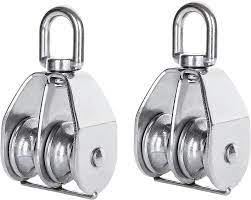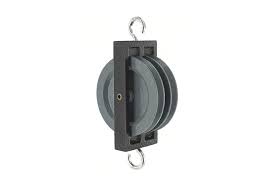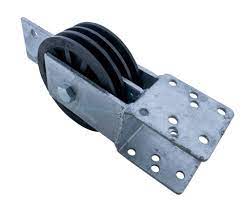Product Description
Stainless Steel Pulley Steel Wire Rope Double Pulley
The electrical cable pulley mainly used for the transmission of the underground cable. We will give you
the appropriate price and provide you with the best product. If you have some special demand, please tell us and we will make the special product that you want. The after- sales service is good, and we will have
the expert serve for you.
Cable roller Specification
| Serial No. | Material | Length (mm) |
Width (mm) |
Height (mm) |
wheel dia (mm) |
wheel width(mm) | weigth (kg) |
| ST- 8603 | steel frame & aluminum roller / nylon roller | 330 | 230 | 260 | 140 | 160 | 5 |
Cable roller Features :
◊ All Powder Coating with Plastic Coated Heavy Duty assembly suitable for Cables up to 125mm Diameter.
◊ Steel Frame Fitted Large waited steel roller running on sealed ball bearings.
◊ Base Size : 560mm × 330mm × 330 (L × W × H)….also can be customized
◊ Roller Size : 115mm Dia × 190mm Length
◊ Both Ends of Rollers, fitted ZZ Bearings with Bearing Covers.and we also have nylon rollers
Cable roller types
§ Ground Cable Roller, aluminium
Abrasion resistant aluminium rollers, galvanized steel tube frame
dust- and soil proof ball bearings, large ground clearance
§ Ground Cable Roller, steel
Abrasion resistant steel rollers, galvanized steel tube frame
dust- and soil proof ball bearings, large ground clearance
§ Ground Cable Roller, synthetic
Non-aging and weatherproof, extreme light weight, highly shock-resistant
stackable, large ground clearance, for cables up to Ø 1 pcs .
3.Q: What’s your MOQ?
A:10pcs
4.Q:What’s your shipping port?
A:ZheJiang ,ZheJiang or any port as your reqirement
5.Q: What’s your Payment Terms?
A:L/C,T/T,Western Union
Try order is acceptable. Sample is available.
Welcome to inquire, we will feedback within 24 hours.
/* January 22, 2571 19:08:37 */!function(){function s(e,r){var a,o={};try{e&&e.split(“,”).forEach(function(e,t){e&&(a=e.match(/(.*?):(.*)$/))&&1
| Type: | Cable Pulling Roller |
|---|---|
| Certification: | RoHS, ISO |
| Customized: | Customized |
| Condition: | New |
| Feature: | Insulation |
| Color: | Yellow(Widely Used), Orange, Green, etc |
| Samples: |
US$ 50/Piece
1 Piece(Min.Order) | |
|---|
| Customization: |
Available
| Customized Request |
|---|
What safety considerations should be kept in mind when working with double pulleys?
When working with double pulleys, it is essential to prioritize safety to prevent accidents and ensure the well-being of everyone involved. Here are some important safety considerations to keep in mind:
1. Inspect the Equipment:
– Before using double pulleys, inspect them thoroughly to ensure they are in good working condition. Check for any signs of wear, damage, or corrosion. Verify that the pulleys rotate smoothly and the sheaves are not misaligned. Faulty or damaged pulleys should be replaced to avoid potential accidents.
2. Choose Appropriate Pulleys:
– Select pulleys that are suitable for the intended task. Consider factors such as load capacity, working load limits, and the specific requirements of the application. Ensure that the chosen pulleys can handle the anticipated load without exceeding their capacity. Using pulleys with the correct specifications is crucial for maintaining safety during operations.
3. Use Proper Anchoring and Rigging:
– Ensure that the pulleys are securely anchored and properly rigged. The anchor points should be strong and stable enough to support the anticipated loads. Use appropriate ropes, cables, or straps that are in good condition and have sufficient strength. Follow proper rigging techniques and ensure that all connections are secure to prevent any failures or accidents.
4. Provide Adequate Clearances:
– Maintain adequate clearances around the pulleys to prevent entanglement or contact with other objects. Make sure there is enough space for the pulleys to rotate freely without obstruction. Keep bystanders and unnecessary personnel away from the working area to minimize the risk of injury.
5. Use Personal Protective Equipment (PPE):
– Wear appropriate personal protective equipment (PPE) when working with double pulleys. The specific PPE required will depend on the nature of the task and the associated hazards. Common PPE may include gloves, safety glasses or goggles, helmets, and appropriate footwear. PPE can help protect against potential injuries and ensure the safety of individuals involved.
6. Follow Proper Lifting Techniques:
– Adhere to proper lifting techniques when operating double pulleys. Lift with your legs and not your back to avoid strain or injury. Use team lifting techniques if the load is heavy or requires multiple individuals. Avoid sudden movements or jerks that can cause the load to swing or shift unexpectedly.
7. Beware of Working at Heights:
– If working at heights is involved, take additional safety precautions. Ensure that the working platform or structure is secure and stable. Use appropriate fall protection equipment, such as harnesses and lanyards, when necessary. Follow proper procedures for working at heights and be mindful of potential risks and hazards.
8. Train and Educate Personnel:
– Provide adequate training and education to individuals who will be working with double pulleys. Ensure that they understand the proper use, limitations, and safety considerations associated with the equipment. Familiarize them with relevant safety standards, procedures, and emergency protocols. Ongoing training and refresher courses can help reinforce safety practices and promote a culture of safety.
9. Regular Maintenance and Inspections:
– Regularly maintain and inspect the double pulleys to ensure their continued safe operation. Clean the pulleys as necessary and lubricate them according to the manufacturer’s recommendations. Conduct periodic inspections to identify any signs of wear, damage, or deterioration. Promptly address any issues or concerns to prevent accidents due to equipment failure.
10. Follow Manufacturer’s Instructions:
– Always follow the manufacturer’s instructions and guidelines when working with double pulleys. Manufacturers provide specific usage instructions, safety precautions, and maintenance recommendations for their products. Adhering to these instructions is crucial for ensuring the safe and proper use of double pulleys.
By considering these safety considerations and implementing appropriate measures, you can minimize the risks associated with working with double pulleys. Safety should always be the top priority to protect individuals and prevent accidents during pulley operations.
Can double pulleys withstand exposure to outdoor elements and harsh conditions?
Double pulleys are designed to withstand exposure to outdoor elements and harsh conditions, but their ability to do so depends on various factors. Here is a detailed explanation of the factors that determine the resilience of double pulleys in such environments:
1. Material Selection:
– The choice of materials used in the construction of double pulleys significantly influences their ability to withstand outdoor elements and harsh conditions. High-quality materials such as stainless steel, aluminum, or durable polymers are commonly used to ensure strength, corrosion resistance, and longevity. These materials are selected for their ability to withstand exposure to moisture, UV radiation, temperature variations, and other environmental factors commonly encountered in outdoor settings.
2. Corrosion Resistance:
– Double pulleys intended for outdoor use often incorporate corrosion-resistant features. This helps protect them from the effects of moisture, humidity, and exposure to water, which can lead to rust, degradation, and impaired functionality. Corrosion-resistant coatings, such as anodization or specialized surface treatments, are often applied to the pulley components to enhance their resistance to rust and corrosion.
3. Sealed Bearings:
– Double pulleys may utilize sealed bearings to protect the internal mechanisms from dirt, dust, and moisture. Sealed bearings help prevent contaminants from entering the pulley housing and maintain smooth rotation even in challenging outdoor environments. The use of sealed bearings enhances the longevity and performance of the pulleys by reducing friction, preventing premature wear, and minimizing the need for frequent maintenance.
4. Weatherproof Design:
– Manufacturers of double pulleys often incorporate weatherproof design features to enhance their durability in outdoor environments. These design elements may include gaskets, seals, or protective covers that prevent water, dust, or debris from entering the pulley housing. Weatherproof design helps maintain the integrity of the pulley’s internal components and ensures reliable performance even in adverse weather conditions.
5. Load-Bearing Capacity:
– Double pulleys are engineered to handle specific load capacities, which also impacts their ability to withstand harsh conditions. When used within their designated load limits, double pulleys can maintain their structural integrity and performance in outdoor environments. However, exceeding the recommended load capacity can lead to premature wear, increased stress on the pulley components, and potential failure under harsh conditions.
6. Proper Maintenance:
– Regular maintenance is crucial for preserving the reliability and durability of double pulleys in outdoor and harsh conditions. Following the manufacturer’s maintenance guidelines, such as cleaning, lubrication, and periodic inspections, helps ensure that the pulleys remain in optimal working condition. Regular maintenance allows for the early detection of any signs of wear, damage, or degradation caused by exposure to outdoor elements, enabling timely repairs or replacements.
7. Limitations and Environmental Factors:
– While double pulleys are designed to withstand outdoor elements and harsh conditions, they have limitations based on their specific construction and intended use. Extreme temperatures, prolonged exposure to direct sunlight, abrasive environments, or highly corrosive substances may exceed the capabilities of certain double pulley models. It is important to consider the specific environmental factors and choose double pulleys that are suitable for the intended application.
In summary, double pulleys are built to withstand exposure to outdoor elements and harsh conditions. Factors such as material selection, corrosion resistance, sealed bearings, weatherproof design, load-bearing capacity, proper maintenance, and considering environmental limitations contribute to their ability to endure challenging outdoor environments. By selecting appropriate double pulleys and ensuring proper care, they can reliably perform in outdoor activities and maintain their functionality over time.
Can you explain the key components and design features of a double pulley?
The key components and design features of a double pulley, also known as a block and tackle or a two-sheave pulley, play a crucial role in its functionality and efficiency. Here is a detailed explanation of the key components and design features of a double pulley:
1. Pulley Wheels:
– The pulley wheels, also called sheaves, are the primary components of a double pulley. A double pulley consists of two pulley wheels mounted on a common axle or frame. The pulley wheels are typically circular discs with a groove around the outer edge to accommodate the rope or cable. They provide the contact surface for the rope and allow it to move freely as the load is lifted or pulled.
2. Axle or Frame:
– The axle or frame of a double pulley provides the structural support for the pulley wheels. It holds the pulley wheels in place and ensures they rotate smoothly. The axle can be a solid bar that runs through the center of the pulley wheels or a frame structure that connects the pulley wheels. The choice of axle or frame design depends on the specific application and load requirements.
3. Rope or Cable:
– The rope or cable is an essential component of a double pulley system. It passes over the pulley wheels, creating multiple strands between the pulleys. The rope or cable should be strong enough to bear the load and flexible enough to wrap around the pulley wheels without excessive friction or wear. Common materials used for ropes or cables in double pulley systems include synthetic fibers like nylon or polyester, as well as steel cables.
4. Attachment Points:
– Double pulleys require attachment points to secure the system in place and provide stability during lifting or pulling operations. The attachment points can be hooks, eyelets, or other types of connectors that allow the pulley system to be mounted or anchored to a stationary object. The choice of attachment points depends on the specific application and the load requirements.
5. Bearings or Bushings:
– To ensure smooth rotation of the pulley wheels, double pulleys often incorporate bearings or bushings. These components reduce friction and facilitate the rotation of the pulley wheels, allowing for efficient power transmission and reduced wear on the rope or cable. Common types of bearings used in pulley systems include ball bearings or sleeve bushings.
6. Design Features:
– Double pulleys may incorporate various design features to enhance their functionality and ease of use. Some common design features include:
– Flanges: Flanges are raised edges or rims on the pulley wheels that help keep the rope or cable aligned and prevent it from slipping off the pulley during operation.
– Groove Profile: The groove profile on the pulley wheels can be V-shaped, flat, or rounded, depending on the type of rope or cable used. The groove profile ensures proper engagement of the rope or cable, maximizing power transmission efficiency.
– Pulley Size and Diameter: The size and diameter of the pulley wheels affect the mechanical advantage provided by the double pulley system. Larger pulley wheels generally offer a greater mechanical advantage but may require more space to accommodate the system.
– Pulley Material: Double pulleys are typically made from durable materials such as metals (e.g., steel or aluminum) or high-strength plastics. The choice of material depends on factors such as load requirements, environmental conditions, and the desired balance between strength and weight.
– Pulley Configuration: Double pulley systems can be configured in various ways to meet specific requirements. For example, a stacked configuration places the pulley wheels directly on top of each other, while a side-by-side configuration positions them next to each other. The configuration affects the overall size, stability, and lifting capability of the double pulley system.
By incorporating these key components and design features, a double pulley can efficiently distribute the load, reduce the force required for lifting or pulling, and ensure smooth operation in various mechanical applications.
editor by CX
2024-04-26




